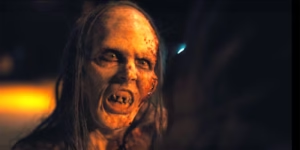
Don’t Trust the House—Or What You Think You Know
Barbarian (2022), directed by Zach Cregger, begins as one kind of film and turns into something else entirely. What starts as a story about a woman double-booked at an Airbnb slowly unravels into a twisted, layered horror that left audiences stunned.
But if you thought it was just a simple genre switch—you missed a lot.
Here are 10 hidden details, symbols, and subtle cues you probably didn’t catch on your first watch.
- The Key Code is More Than Just a Number
The lockbox code Tess enters at the beginning is 8371—a detail that seems insignificant, but fans on Reddit pointed out it’s the ZIP code for a small Michigan area known for abandoned housing. This reinforces the setting as a forgotten, decaying neighborhood.
It’s not just a creepy house. It’s part of a systematic urban rot—which ties directly to the film’s social themes.
- Justin Long’s Role Mirrors Real Scandals
When AJ (Justin Long) is accused of sexual misconduct, many viewers saw this as a fictional subplot. But his character arc intentionally mirrors real-life #MeToo allegations in Hollywood, particularly the shallow “redemption” arcs often seen in media. AJ’s casual dismissal of guilt and tone-deaf behavior are deliberate commentary.
- The Bottle Scene Echoes Childcare Horror
The grotesque moment where Tess is forced to drink milk from a filthy bottle is more than just gross-out horror. It’s a twisted perversion of motherhood. Director Zach Cregger revealed in interviews that the bottle, the lullabies, and the “nursery” setting were inspired by real-life stories of women held captive for decades.
- The Camera Lens Gets Narrower as the Film Progresses
Notice how wide the camera shots are early in the film—giving you the feeling of space and movement. But as Tess descends into the tunnels, the cinematography tightens, creating a claustrophobic effect.
By the time we meet the “Mother,” the aspect ratio compresses visually, heightening the sense of panic and helplessness.
- Bill Skarsgård’s Casting Is a Psychological Misdirect
Skarsgård, famous for playing Pennywise in It, was cast specifically to make the audience suspicious of his character, Keith. His awkward behavior, wide eyes, and hesitations are written to feel “off.” But the twist? Keith is innocent.
The film uses your horror knowledge against you.
- Frank’s Store Video Is a Map of His Crimes
When Tess finds Frank’s VHS collection, the labels aren’t just disturbing—they’re revealing. Each label (e.g., “Redhead at gas station,” “Room 3,” “No name”) is a record of a real person he abducted. According to production notes, the team spent hours creating fake tapes to reflect his years of abuse.
- The Mother Mimics the Victim’s Lives
The “Mother” creature is not just a monster. Her behaviors—bottle-feeding, lullabies, dragging people to bed—mirror how she was raised and what she saw growing up in Frank’s prison. She’s a victim of generational trauma, not a supernatural being.
Her violence stems from warped nurture, not nature.
- AJ’s Flashlight Falls Like Tess’s Early Warning
Remember how Tess sees a mirror reflection warning her about the passageway early on? In a later scene, AJ drops his flashlight and follows it deeper into the tunnels. This mirroring emphasizes their opposite character traits: Tess hesitates, AJ barrels forward.
One listens. The other doesn’t.
- The Neighborhood Is Symbolic of Forgotten Crimes
The boarded-up houses and decay are symbolic. As Detroit’s real-life housing crisis serves as the backdrop, the movie subtly critiques how ignored, low-income communities can become breeding grounds for long-hidden atrocities.
- The Ending Repeats the Opening
The movie begins with Tess walking into the house and ends with her walking away from it. But now, she’s stronger. She’s bloody, broken, and traumatized—but alive.
The house is still there. The system that allowed it to exist is still there. But Tess escapes it—a final metaphor for breaking cycles of abuse.
Final Thoughts
Barbarian rewards second and third viewings. Its horror lies not just in the jump scares, but in the quiet details, the themes of systemic failure, and the slow unraveling of identity, trauma, and trust.
If you thought it was just another creature feature—watch it again. There’s a terrifying world beneath the surface.
Rating: ★★★★☆ (4/5)
A brilliantly layered horror film that proves the scariest monsters are the ones we create ourselves.
Tags: Barbarian movie, horror easter eggs, Zach Cregger, Bill Skarsgård, Tess, Mother character, horror film analysis
Category: Horror Movie Analysis





















